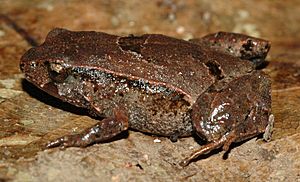Pouched frog facts for kids
Quick facts for kids Pouched frog |
|
|---|---|
 |
|
| Conservation status | |
| Scientific classification | |
 |
|
| Range of the pouched frog |
The pouched frog (Assa darlingtoni), also known as the hip pocket frog, is a small frog that lives on land. You can find it in rainforests in the mountains of south-eastern Queensland and northern New South Wales, Australia. It is the only species in its group, Assa, and belongs to the frog family Myobatrachidae.
Contents
What Does It Look Like?
This frog is quite small, usually about 2.5 cm long. It is reddish-brown in color. Some pouched frogs have V-shaped marks on their backs. Others might have light brown dots scattered around.
Most of these frogs have a darker brown stripe. This stripe goes from their nose, through their eye, and down the side of their body. There is also a special skin fold on each side of the frog. It runs from its eye all the way to its hip.
The pouched frog's hands and feet do not have webbing. The tips of its fingers and toes are a bit swollen. Its eyes are gold with small brown spots. When the pupil gets smaller, it looks like a horizontal line.
The most unique thing about this frog is the 'pocket' on its hip. This is where the male frog carries its tiny tadpoles after they hatch!
Where It Lives and What It Does
This frog likes to hide under logs, rocks, and fallen leaves. You can find it in rainforests and nearby wet sclerophyll forests. It might call out during the day, but it calls the most around sunrise and sunset. Its call is very quiet. It sounds like "eh-eh-eh-eh-eh-eh," usually with six to ten notes.
Unlike many frogs, the pouched frog crawls instead of hopping.
Reproduction and Life Cycle
Female pouched frogs are thought to start breeding when they are about 2 or 3 years old. A single female can lay between 1 and 50 eggs each year.
The eggs are laid on land, not in water. They are often found under rotting logs, rocks, or leaf litter. This is because the tadpoles do not need water to change into frogs. Breeding happens during spring and summer.
Both male and female frogs help guard the nest of eggs. After the tadpoles hatch, the male frog carries them in the special pouch on his hip. The tadpoles stay in this pouch until they have fully changed into tiny frogs.
This frog species used to have fewer numbers, but its population has now recovered and is healthy.
Similar Frogs
Even though the pouched frog is the only species in its own group, it can sometimes be confused with another frog called Philoria loveridgei (Loveridge's frog).
You can tell them apart by looking closely. Philoria loveridgei has angular skin folds on its back. It also has thicker arms than the pouched frog.
- New South Wales Office of Environment and Heritage (2014) 'Pouched Frog- profile', accessed 7 August 2016.
See also
 In Spanish: Assa darlingtoni para niños
In Spanish: Assa darlingtoni para niños


